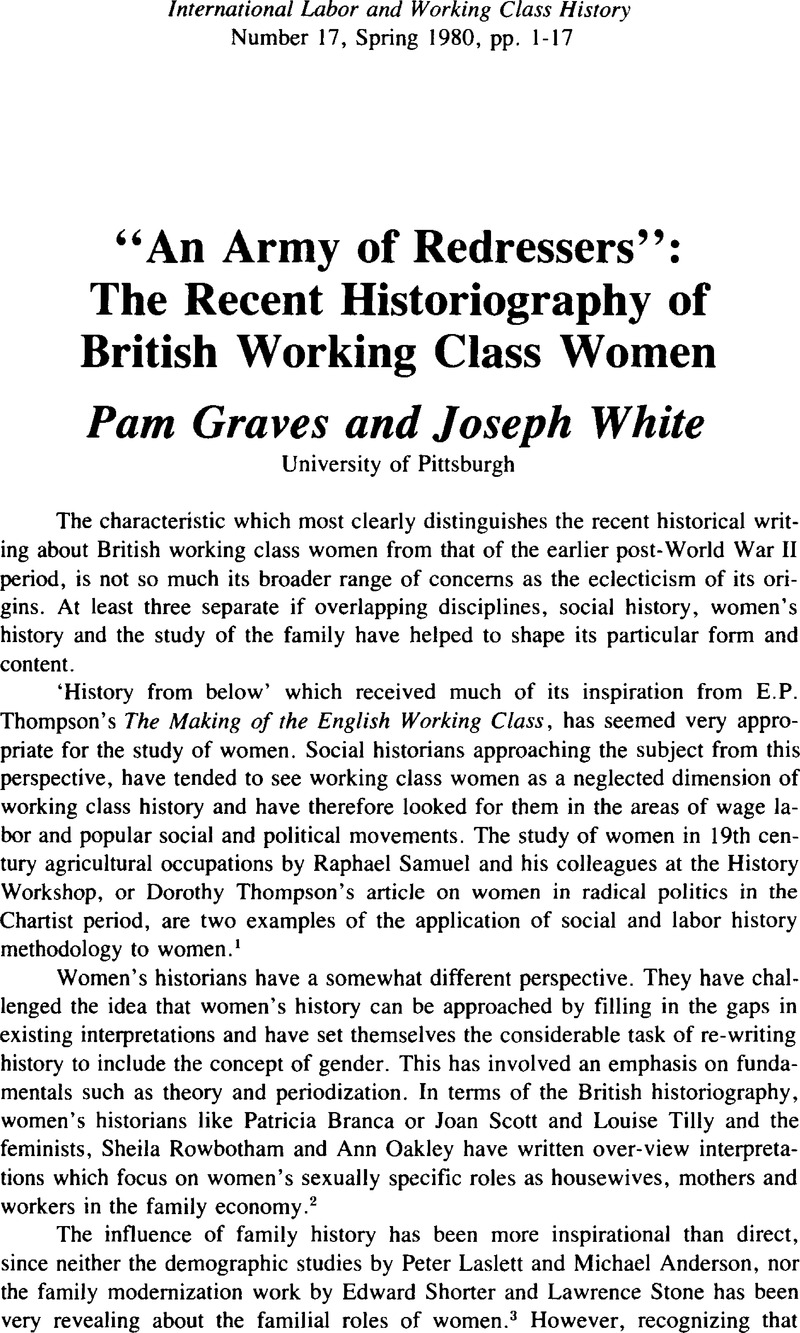Published online by Cambridge University Press: 16 December 2008

1. Samuel, Raphael, Village Life and Labour (London: Routledge & Kegan Paul Ltd., 1975)Google Scholar; Thompson, Dorothy, “Women and 19th century Radical Politics, A Lost Dimension,” in Mitchell, Juliet and Oakley, Ann ed., The Rights and Wrongs of Women (London: Penguin Books, 1976).Google Scholar
2. Branca, Patricia, Women in Europe Since 1750 (New York: St. Martins Press, 1978)Google Scholar; Tilly, Louise and Scott, Joan, Women, Work and Family (New York: Holt, Rinehart & Winston, 1978)Google Scholar; Rowbotham, Sheila, Hidden from History, Rediscovering Women in History from the 17th century to the Present (London: Pluto Press, 1973)Google Scholar; Oakley, Ann, Women's Work, the Housewife Past and Present (London: 1974).Google Scholar
3. Laslett, Peter ed., Household and Family in Past Time (CambridgeUniversity Press, 1972)CrossRefGoogle Scholar; Anderson, Michael, Family Structure in Nineteenth Century Lancashire (Cambridge University Press, 1971)Google Scholar; Shorter, Edward, The Making of the Modern Family (1975)Google Scholar; Stone, Lawrence, The Family, Sex and Marriage in England, 1500–1800 (New York: 1977).Google Scholar
4. Stanley, Mary Lyndon, “Review Essay” Signs, 4 (Summer 1979), 750.Google Scholar
5. Oren, Laura, “The Welfare of Women in Labouring Families in England 1860–1950” Feminist Studies, 1 (1973)Google Scholar; “‘A Torrent of Abuse’ Crimes of Violence Between British Working Class Men and Women in London 1840–1875,” Journal of Social History, 2 (1977–1978), 328–342Google Scholar; McLaren, Angus, “Women's Work and The Regulation of Family Size” History Workshop Journal, 4 (Autumn 1975)Google Scholar; Humphries, Jane, “The Working Class Family, Women's Liberation and the Class Struggle—The Case of 19th Century British History,” Review of Radical Political Economy, 9 (Fall, 1977), 25–40.CrossRefGoogle Scholar
6. Pinchbeck, Ivy, Women Workers in the Industrial Revolution, 1750–1850 (London: 1930)Google Scholar; Hewitt, Margaret, Wives and Mothers in Victorian Industry (London: 1958).Google Scholar
7. The major occupational studies have been of women in agricultural labor and domestic service: Kitteringham, Jenny, “Country girls in 19th century Village Life,” in Raphael Samuel ed. Village Life and LabourGoogle Scholar;, Horn, Pam, The Rise and Fall of the Victorian Servant (Dublin: Gill & McMillan, 1975)Google Scholar; McBride, Theresa, The Domestic Revolution (New York: Holmes & Meier, 1976).Google Scholar
8. Richards, Eric, “Women in the British Economy Since 1700,” History, 59 (1974), 350.CrossRefGoogle Scholar
9. Branca's earlier work, Silent Sisterhood, (1975)Google Scholar is not reviewed here because it concerns lower middle class housewives and is therefore beyond the limits of this article. Other studies omitted for this reason include: Holcombe, Lee, Victorian Ladies At Work—Middle Class Working Women in England and Wales, 1850–1914 (1973)Google Scholar; Davidoff, Leonore, The Best Circles—Women and Society in Victorian England (New Jersey: Rowman and Littlefields, 1973).Google Scholar
10. Lewenhack, Sheila, Women and Trade Unions (London, 1977), 121–25.Google Scholar
11. Thompson, , Women in 19th century Radical Politics, 137.Google Scholar
12. Branca, , Women in Europe Since 1750, 46.Google Scholar
13. Burnett, John, Annals of Labour (Bloomington: Indiana Press, 1974)Google Scholar; Roberts, Robert, The Classic Slum.Google Scholar
14. Lewenhak, , Women and the Trade Unions.Google Scholar
15. Branca, , Women in Europe since 1750, 39.Google Scholar
16. Edinburgh Review, 115 (04, 1862), 211Google Scholar; Burnett, , Annals of Labour (Winifred Foley, General Maid), 227.Google Scholar
17. Davidoff, , The Best Circles, 88.Google Scholar
18. Gillis, John, “Servants Sexual Relations and Risks of Illegitimacy in London, 1801–1900,” Feminist Sludies, 5 (Spring 1979).Google Scholar
19. Alexander, Sally, “Women's Work in 19th century London; A Study of the Years 1820–1850,” in Mitchell, Juliet and Oakley, Ann ed. The Rights and Wrongs of Women (Penguin Books, Middlesex, England, 1976).Google Scholar
20. Ibid., 78.
21. Humphries, , “The Working Class Family.”Google Scholar
22. Alexander, , “Women's Work in 19th century London,” 62–3.Google Scholar
23. Thompson, Dorothy, “Women in 19th century Radical Politics,” 138.Google Scholar
24. Thane, Pat, “Women and the Poor Law in Victorian and Edwardian England,” History Workshop Journal, 6 (Autumn 1978), 34.CrossRefGoogle Scholar
25. Walkowitz, Judith, “The Making of an Outcast Group; Prostitutes and Working Women in 19th Century Plymouth and Southampton,” in Vicinus, Martha ed., A Widening Sphere (Indiana University Press, 1977), 72.Google Scholar
26. Ibid., 92.
27. Tilly, Louise and Scott, Joan, “Women's Work and Family in 19th century Europe,” Comparative Studies in Society and History, 17 (1978), 36–64.Google Scholar
28. Tilly, and Scott, , Women, Work and Family, 77.Google Scholar
29. Ibid., 8.
30. Samuel, Raphael, “The Workshop of the World: Steam Power and Hand Technology in mid Victorian Britain,” History Workshop Journal, 3 (Spring 1977), 13.CrossRefGoogle Scholar
31. Lasch, Christopher, “The Family and History,” New York Review of Books, 13 (11 and 12, 1975)Google Scholar; Thompson, E.P., New Society, 41 No. 779 (09, 1977), 499.Google Scholar
32. Humphries, , “The Working Class Family,” 33.Google Scholar A similar process to that described by Humphries took place in Bethnal Green in the 1950's. See Young, and Wilmot, , Family and Kinship in East London (London: Penguin Books, 1957).Google Scholar
33. Humphries, , “The Working Class Family,” 36.Google Scholar
34. Ibid., 38.
35. McLaren, Angus, Birth Control in 19th century England (New York: Holmes and Meier, 1978)Google Scholar; McLaren, , “Women's Work and the Regulation of Family Size,” History Workshop Journal, 4 (Autumn, 1975).Google Scholar
36. Liddington, Jill and Morris, Jill, One Hand Tied Behind Us; The Rise of the Women's Suffrage Movement (London: Virago Press, 1979).Google Scholar
37. Soldon, Norbert C., Women in British Trade Unions, 1874–1976 (Dublin and Totowa; Gill and Macmillan, Rowan and Littlefield, 1978).Google Scholar
38. Lewenhak, , Women and Trade Unions.Google Scholar
39. Lewenhak, 188.
40. Lewenhak, 114–28; Soldon, 51–72.
41. Harrison, Brian, Separate Spheres: The Opposition to Woman Suffrage in Britain (New York: Holmes and Meier, 1978).Google Scholar
42. Harrison, 91.
43. Harrison, 177.
44. Harrison, 176.
45. Liddington, and Norris, , One Hand Tied Behind Us.Google Scholar
46. Liddington and Norris, 218.
47. Liddington and Norris, 263.